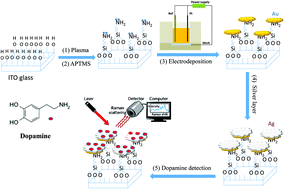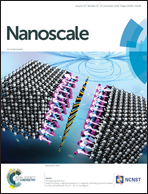Reliable and quantitative SERS detection of dopamine levels in human blood plasma using a plasmonic Au/Ag nanocluster substrate†
Abstract
Accurate and rapid blood-based detection of dopamine levels can aid in the diagnosis and monitoring of diseases related to dopaminergic dysfunction. For the sensitive detection of dopamine levels in human blood plasma (i.e., plasma dopamine levels), a silver-plated Au bimetallic nanocluster (so called plasmonic Au/Ag nanocluster) was prepared as a surface-enhanced Raman scattering (SERS) substrate by the combination of electrodeposition and electroless plating methods. The plasmonic effect of the Au/Ag nanocluster substrate was optimized by controlling the particle morphology, packing density, and interparticle distance, showing the best performance in its SERS activity. The lowest detection limit of dopamine was ∼10−11 M. A linear standard curve was obtained by plotting the log-scale of dopamine concentration (log C) versus Raman intensity at 1152 cm−1. The optimized SERS substrate quantified the plasma dopamine levels of patients with antipsychotic drug-induced Parkinsonism (n = 15) as 3.24 × 10−9 M and healthy control subjects (n = 15) as 2.31 × 10−8 M. Patients with drug-induced Parkinsonism had ∼86% lower plasma dopamine concentration than healthy subjects (two-tailed p-value = 0.000002), indicating a clear separation between the groups. Our study provides the first report on the quantitative SERS detection of dopamine levels in human blood plasma with Parkinsonism. The results highlight the potential clinical utility of the optimized SERS technique in screening clinical populations with dopaminergic dysfunction, i.e., differentiating between healthy subjects and patients with Parkinsonism.



 Please wait while we load your content...
Please wait while we load your content...